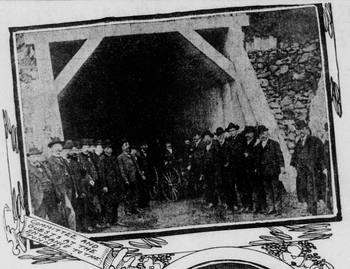 1934 photo of old and new tunnels 2
1934 photo of old and new tunnels 2
The Kennedy Tunnel (officially the Inter-County Tunnel) (1903–c. 1940) was a single-bore tunnel connecting Oakland with Contra Costa County located above today's Caldecott Tunnel. It had several purposes: to provide a safer alternative to the dangerously steep roads over the hills, to encourage Contra Costa residents to come shop in Oakland, and to encourage people to move to Contra Costa County.
The Inter-County Tunnel was the completion of an earlier and partially-completed tunnel known as the Kennedy Tunnel, named for L.W. Kennedy who, in the 1870s, organized an early attempt that failed to construct a tunnel and toll road in the hills between Oakland and Contra Costa County. "Work was begun upon the hole in the hill, but a rush of water was struck to the extent that it collapsed the tunnel and the company at the same time." 1 The site of this failed attempt then lay idle for some 25 years before a new attempt was made in the early 1900s by a group of businessmen from Alameda and Contra Costa Counties. This attempt succeeded and the Inter-County Tunnel was dedicated and opened on November 4, 1903. Note that much of the road to the tunnel was built upon roadway originally graded as part of the ill-fated construction of the original Kennedy Tunnel.
Note that other sources claim that Wright F. Kelsey was the first to propose building a tunnel between the counties.
 Unknown source and date; posted on Facebook
Unknown source and date; posted on Facebook
and labeled Broadway Tunnel from Metropolitan Transportation Commission
from Metropolitan Transportation Commission  Oakland Tribune
Oakland Tribune
March 10, 1934 4
Only one horse carriage or wagon could cross through the problem-plagued tunnel at a time; this led to long waits. The road up to the tunnel was treacherous, and the tunnel was dark, so travelers had to carry lanterns. Even after the tunnel was widened a bit and lights installed so cars could drive through, water seepage from the hillside still caused frequent closures.
During its heyday, as many as 30,000 horse-drawn buggies, pedestrians and cars traversed the tunnel weekly.
In 1935 the Berkeley Gazette reported that “on April 19, the small automobile tunnel through the East Bay Hills was closed due to landslides at the east end caused by rain-soaked hillsides.” 3
After the Caldecott Tunnel opened in 1937, the Inter-County Tunnel continued to be used by pedestrians until the 1940s. Safety concerns led to the tunnel being permanently sealed in 1947. Today it stands dark, empty and mysterious, 300 feet above the Caldecott Tunnel.
Since its initial planning in the 1890s, some people have referred to the tunnel as the Kennedy Tunnel 4 or "the old Kennedy tunnel," although that was technically the name of the unfinished tunnel that was eventually turned into the Inter-County Tunnel. While it was in use, it was mostly described as the tunnel through the East Bay Hills, or using the overly long but descriptive Alameda-Contra Costa County Tunnel, or using the official Inter-County Tunnel name. 5,6,7
Note also that a plaque installed by E Clampus Vitus says it was called the Broadway Tunnel, but we cannot find any sources using that name prior to installation of the plaque and there was never a direct connection between Broadway and Tunnel Road, so this name seems unlikely. The Caldecott Tunnel on the other hand, was often referred to the as the "Broadway tunnel" and was officially known as the Broadway Low Level Tunnel before being renamed after former Berkeley mayor Thomas Caldecott.
 CC SA-BY Our Oakland
CC SA-BY Our Oakland CC SA-BY Our Oakland
CC SA-BY Our Oakland
Links and References
-
Tunnel Dedication Marks Progress of The New Time San Francisco Call November 5, 1903
-
The Caldecott Tunnels California Highways and Public Works July-August 1965
- Berkeley History: Federal funds sought for East Bay Parks in 1935 by Steven Finacom Berkeley Voice April 22, 2010
- Alameda and Contra Costa Tunnel Oakland Tribune February 9, 1903
- Lay Tracks So As To Start Suit Oakland Tribune April 19, 1909
- Old Tunnel Timbers Crash Oakland Tribune March 10, 1934
- Timber Blocks Tunnel Road Oakland Tribune March 10, 1934
- Notes From Over the Bay San Francisco Call September 9, 1892
- The Work Begun Oakland Tribune May 24, 1897
- Surface Road to Contra Costa Oakland Tribune March 27, 1901
- View the Tunnel Site Alameda Daily Argus May 15, 1901
- Alameda County Board of Supervisors official notice of acceptance of Bid on Kennedy Tunnel Road Oakland Tribune September 13, 1902
- Supervisors of Two Counties are Tunneling San Francisco Call February 20, 1903
- Work of Supervisors on Inter-County Road Oakland Tribune November 4, 1903
-
Knave -- Kennedy Tunnel Oakland Tribune June 21, 1959
-
Days Gone By: Depression gives the Caldecott Tunnel a leg up Oakland Tribune July 15, 2010
- The Kennedy Tunnel The New York Times October 1, 2011
-
Photos: Memories of the East Bay’s “mystery tunnel” San Jose Mercury November 8, 2013
-
Before Caldecott opened, mysterious tunnel connected counties Contra Costa Times November 10, 2013
- Caldecott Tunnel - 100 years of History Orinda Historical Society Newsletter
- The Old Tunnel (one of them) Oakland Geology
- The Board of Supervisors Oakland Tribune September 13, 1902




